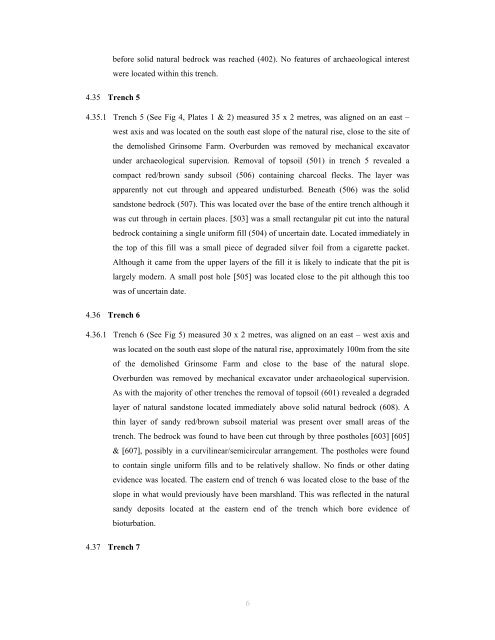Ince Marsh, Helsby Cheshire - Archaeology Data Service
Ince Marsh, Helsby Cheshire - Archaeology Data Service
Ince Marsh, Helsby Cheshire - Archaeology Data Service
Create successful ePaper yourself
Turn your PDF publications into a flip-book with our unique Google optimized e-Paper software.
efore solid natural bedrock was reached (402). No features of archaeological interest<br />
were located within this trench.<br />
4.35 Trench 5<br />
4.35.1 Trench 5 (See Fig 4, Plates 1 & 2) measured 35 x 2 metres, was aligned on an east –<br />
west axis and was located on the south east slope of the natural rise, close to the site of<br />
the demolished Grinsome Farm. Overburden was removed by mechanical excavator<br />
under archaeological supervision. Removal of topsoil (501) in trench 5 revealed a<br />
compact red/brown sandy subsoil (506) containing charcoal flecks. The layer was<br />
apparently not cut through and appeared undisturbed. Beneath (506) was the solid<br />
sandstone bedrock (507). This was located over the base of the entire trench although it<br />
was cut through in certain places. [503] was a small rectangular pit cut into the natural<br />
bedrock containing a single uniform fill (504) of uncertain date. Located immediately in<br />
the top of this fill was a small piece of degraded silver foil from a cigarette packet.<br />
Although it came from the upper layers of the fill it is likely to indicate that the pit is<br />
largely modern. A small post hole [505] was located close to the pit although this too<br />
was of uncertain date.<br />
4.36 Trench 6<br />
4.36.1 Trench 6 (See Fig 5) measured 30 x 2 metres, was aligned on an east – west axis and<br />
was located on the south east slope of the natural rise, approximately 100m from the site<br />
of the demolished Grinsome Farm and close to the base of the natural slope.<br />
Overburden was removed by mechanical excavator under archaeological supervision.<br />
As with the majority of other trenches the removal of topsoil (601) revealed a degraded<br />
layer of natural sandstone located immediately above solid natural bedrock (608). A<br />
thin layer of sandy red/brown subsoil material was present over small areas of the<br />
trench. The bedrock was found to have been cut through by three postholes [603] [605]<br />
& [607], possibly in a curvilinear/semicircular arrangement. The postholes were found<br />
to contain single uniform fills and to be relatively shallow. No finds or other dating<br />
evidence was located. The eastern end of trench 6 was located close to the base of the<br />
slope in what would previously have been marshland. This was reflected in the natural<br />
sandy deposits located at the eastern end of the trench which bore evidence of<br />
bioturbation.<br />
4.37 Trench 7<br />
6

















